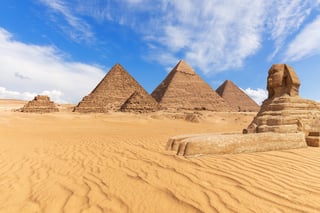The Pyramids of Giza are a trio of ancient Egyptian pyramids located on the west bank of the Nile River in northern Egypt. Among them, the Great Pyramid of Giza, also known as the Great Pyramid of Khufu, stands as one of the most iconic structures in human history.
This colossal pyramid, constructed during Egypt's 4th dynasty, is renowned for its architectural brilliance and historical significance.
In this article, we will delve into the details of the Great Pyramid and its counterparts, exploring their history, architecture, construction techniques, and the mysteries that continue to surround them.

Great Pyramid of Giza
Historical Background
- The Great Pyramid of Giza was built during the reign of Pharaoh Khufu (also known as Cheops), the second king of Egypt's 4th dynasty, which dates back to approximately 2575–2465 BCE.
- It was completed around 2560 BCE and is considered one of the Seven Wonders of the World, with the distinction of being the last surviving wonder.
Architecture
- Originally, the Great Pyramid stood at an impressive height of 482 feet (147 meters), but erosion and the removal of polished limestone casing stones have reduced its height to 449 feet (137 meters).
- The pyramid's base and sides each measure 755 feet (230 meters) in length.
- The pyramid has a precise orientation to the four cardinal points of the compass, showcasing the ancient Egyptians' remarkable astronomical and engineering skills.
- Its core is constructed from yellowish limestone blocks, while the inner passages are made from finer light-colored limestone. The burial chamber itself is built from massive granite blocks.
- To create this architectural marvel, an astounding 2.3 million stone blocks, totaling a staggering 5.75 million tons in weight, were quarried, transported, and meticulously assembled.
- The precision of the masonry, both in the internal walls and the few remaining outer-casing stones, is unparalleled in ancient Egyptian construction.
Interior Structure
- The entrance to the Great Pyramid is located on its north side, approximately 59 feet (18 meters) above ground level.
- The pyramid's interior contains a descending corridor that passes through the masonry, extends into the rocky soil, and terminates in an unfinished underground chamber.
- An ascending passageway branches off from the descending corridor, leading to the Queen's Chamber and a great slanting passageway known as the Grand Gallery.
- The King's Chamber, the main burial room, is entirely lined and roofed with granite and is accessible via a long, narrow passage from the Grand Gallery.
- Above the King's Chamber, five compartments are separated by massive horizontal granite slabs, possibly designed to distribute the immense weight of the overlying masonry.
Construction Techniques
- The methods used for building the Great Pyramid have long intrigued historians and archaeologists.
- One plausible theory suggests that the ancient Egyptians employed a sloping and encircling embankment of brick, earth, and sand to create a ramp that increased in height as the pyramid was constructed.
- Stone blocks were transported up this ramp using sledges, rollers, and levers.
- Herodotus, the ancient Greek historian, estimated that the construction of the Great Pyramid took 20 years and required the labor of 100,000 men. However, more recent evidence suggests a potentially smaller, permanent workforce of as few as 20,000 workers, supported by various personnel.
The Other Pyramids of Giza
- The Pyramids of Giza consist of three main pyramids: Khufu's, Khafre's, and Menkaure's.
- Khufu's pyramid, also known as the Great Pyramid, is the largest and oldest of the trio. Its sides rise at an angle of 51°52′ and are accurately oriented to the cardinal points.
- Khafre's pyramid is the second-largest and was built for the fourth king of the 4th dynasty. It retains some of its outer limestone casing at the top.
- Menkaure's pyramid is the smallest of the three, constructed for the fifth king of the 4th dynasty.
Archaeological Discoveries
- Formal excavations of the Great Pyramid began in the 19th century, with notable discoveries like laborers' graffiti confirming Khufu as its builder.
- Two boats were uncovered near the Great Pyramid, although Khufu's remains have never been found.
- Modern technology, including 3D scanners, has been used to explore the pyramids, leading to the recent discovery of hidden corridors within the Great Pyramid.
Legacy and UNESCO World Heritage Site
- In ancient times, the Pyramids of Giza were celebrated as part of the Seven Wonders of the World.
- Today, they continue to captivate people worldwide and have been designated as a UNESCO World Heritage site since 1979.
- Adjacent to the Great Pyramid lies the Great Sphinx, a remarkable monument with the body of a recumbent lion and the facial features of a man.
The Pyramids of Giza stand as enduring symbols of ancient Egyptian civilization, showcasing the remarkable engineering prowess and cultural significance of this ancient civilization. While many questions remain about their construction, they remain a testament to human ingenuity and architectural achievement.
To help us improve